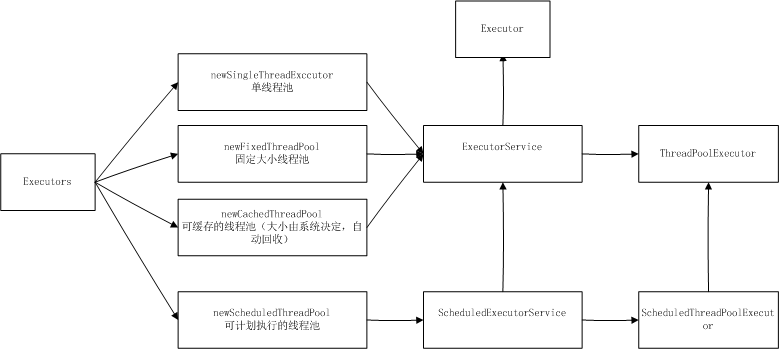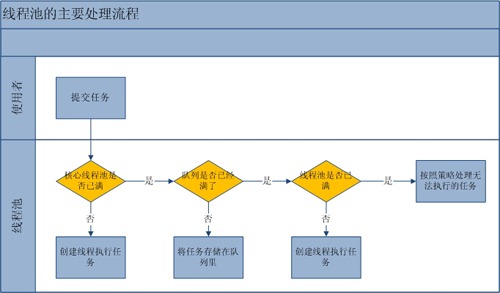您好,登錄后才能下訂單哦!
您好,登錄后才能下訂單哦!
今天就跟大家聊聊有關一文帶你讀懂Java 線程池框架,可能很多人都不太了解,為了讓大家更加了解,小編給大家總結了以下內容,希望大家根據這篇文章可以有所收獲。
一、線程池結構圖

二、示例
定義線程接口
public class MyThread extends Thread {
@Override
publicvoid run() {
System.out.println(Thread.currentThread().getName() + "正在執行");
}
}1:newSingleThreadExecutor
ExecutorService pool = Executors. newSingleThreadExecutor(); Thread t1 = new MyThread(); Thread t2 = new MyThread(); Thread t3 = new MyThread(); //將線程放入池中進行執行 pool.execute(t1); pool.execute(t2); pool.execute(t3); //關閉線程池 pool.shutdown();
輸入結果:
pool-1-thread-1正在執行 pool-1-thread-1正在執行 pool-1-thread-1正在執行
2:newFixedThreadPool
ExecutorService pool = Executors.newFixedThreadPool(3); Thread t1 = new MyThread(); Thread t2 = new MyThread(); Thread t3 = new MyThread(); Thread t4 = new MyThread(); Thread t5 = new MyThread(); //將線程放入池中進行執行 pool.execute(t1); pool.execute(t2); pool.execute(t3); pool.execute(t4); pool.execute(t5); pool.shutdown();
輸入結果:
pool-1-thread-1正在執行 pool-1-thread-2正在執行 pool-1-thread-1正在執行 pool-1-thread-2正在執行
3 :newCachedThreadPool
ExecutorService pool = Executors.newCachedThreadPool(); Thread t1 = new MyThread(); Thread t2 = new MyThread(); Thread t3 = new MyThread(); Thread t4 = new MyThread(); Thread t5 = new MyThread(); //將線程放入池中進行執行 pool.execute(t1); pool.execute(t2); pool.execute(t3); pool.execute(t4); pool.execute(t5); //關閉線程池 pool.shutdown();
輸入結果:
pool-1-thread-2正在執行 pool-1-thread-4正在執行 pool-1-thread-3正在執行 pool-1-thread-1正在執行 pool-1-thread-5正在執行
4 :ScheduledThreadPoolExecutor
ScheduledExecutorService pool = Executors.newScheduledThreadPool(2);
pool.scheduleAtFixedRate(new Runnable() {//每隔一段時間就觸發異常
@Override
public void run() {
//throw new RuntimeException();
System.out.println("================");
}
}, 1000, 2000, TimeUnit.MILLISECONDS);
pool.scheduleAtFixedRate(new Runnable() {//每隔一段時間打印系統時間,證明兩者是互不影響的
@Override
public void run() {
System.out.println("+++++++++++++++++");
}
}, 1000, 2000, TimeUnit.MILLISECONDS);輸入結果:
================ +++++++++++++++++ +++++++++++++++++ +++++++++++++++++
三、線程池核心參數
corePoolSize : 池中核心的線程數
maximumPoolSize : 池中允許的最大線程數。
keepAliveTime : 當線程數大于核心時,此為終止前多余的空閑線程等待新任務的最長時間。
unit : keepAliveTime 參數的時間單位。
workQueue : 執行前用于保持任務的隊列。此隊列僅保持由 execute方法提交的 Runnable任務。
threadFactory : 執行程序創建新線程時使用的工廠。
handler : 由于超出線程范圍和隊列容量而使執行被阻塞時所使用的處理程序。
ThreadPoolExecutor :Executors類的底層實現。
3.1 任務排隊機制
SynchonousQueue: 同步隊列,隊列直接提交給線程執行而不保持它們,此時線程池通常是無界的
LinkedBlockingQueue: 無界對列,當線程池線程數達到最大數量時,新任務就會在隊列中等待執行,可能會造成隊列無限膨脹
ArrayBlockingQueue : 有界隊列,有助于防止資源耗盡,一旦達到上限,可能會造成新任務丟失
注意:
newSingleThreadExecutor、newFixedThreadPool使用的是LinkedBlockingQueue
newCachedThreadPool 使用的是 SynchonousQueue
newScheduledThreadPool使用的是 DelayedWorkQueue
3.2 線程執行流程

3.3 線程大小確定:
cpu密集型: 盡量少開線程,最佳線程數 Ncpu+1
io密集型:多開線程,2Ncpu
混合型:根據情況而定,可以拆分成io密集和cou密集
看完上述內容,你們對一文帶你讀懂Java 線程池框架有進一步的了解嗎?如果還想了解更多知識或者相關內容,請關注億速云行業資訊頻道,感謝大家的支持。
免責聲明:本站發布的內容(圖片、視頻和文字)以原創、轉載和分享為主,文章觀點不代表本網站立場,如果涉及侵權請聯系站長郵箱:is@yisu.com進行舉報,并提供相關證據,一經查實,將立刻刪除涉嫌侵權內容。